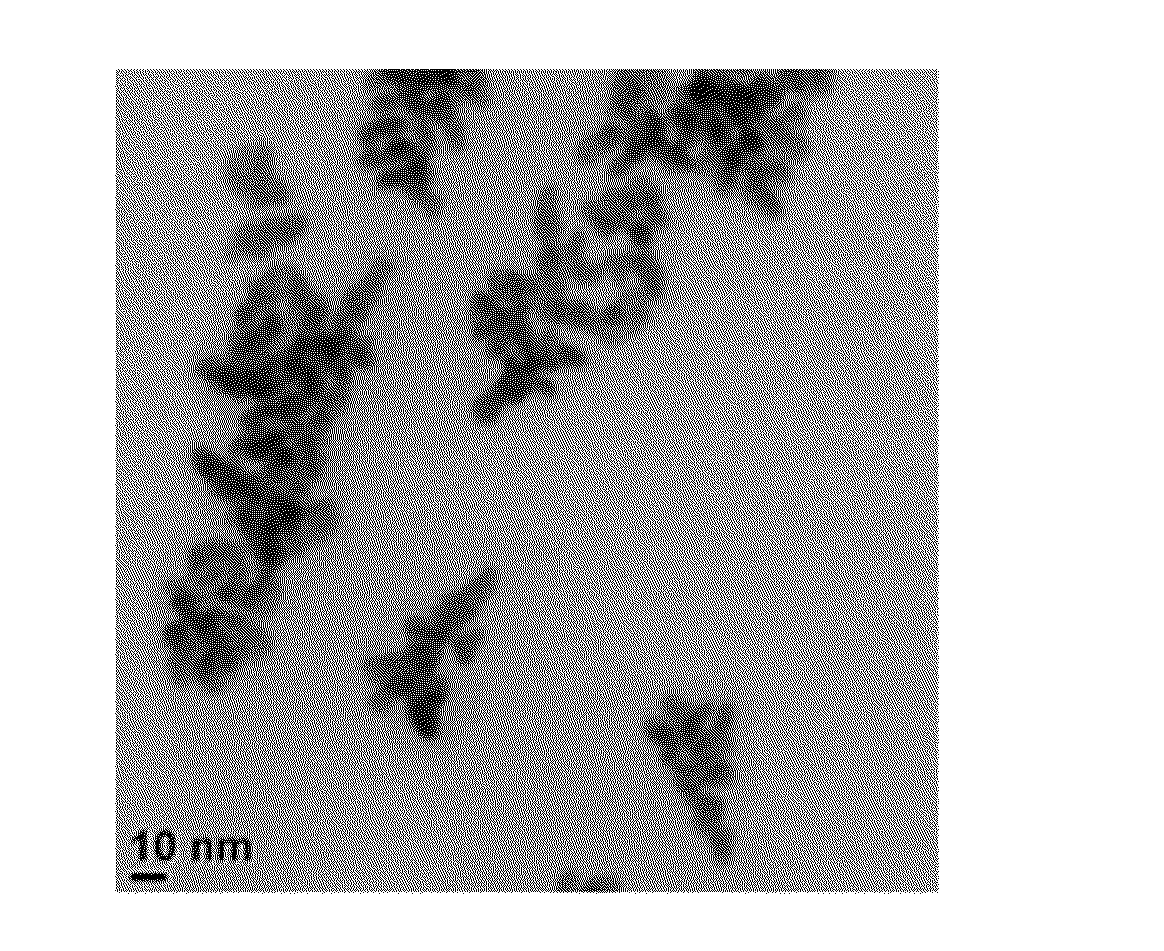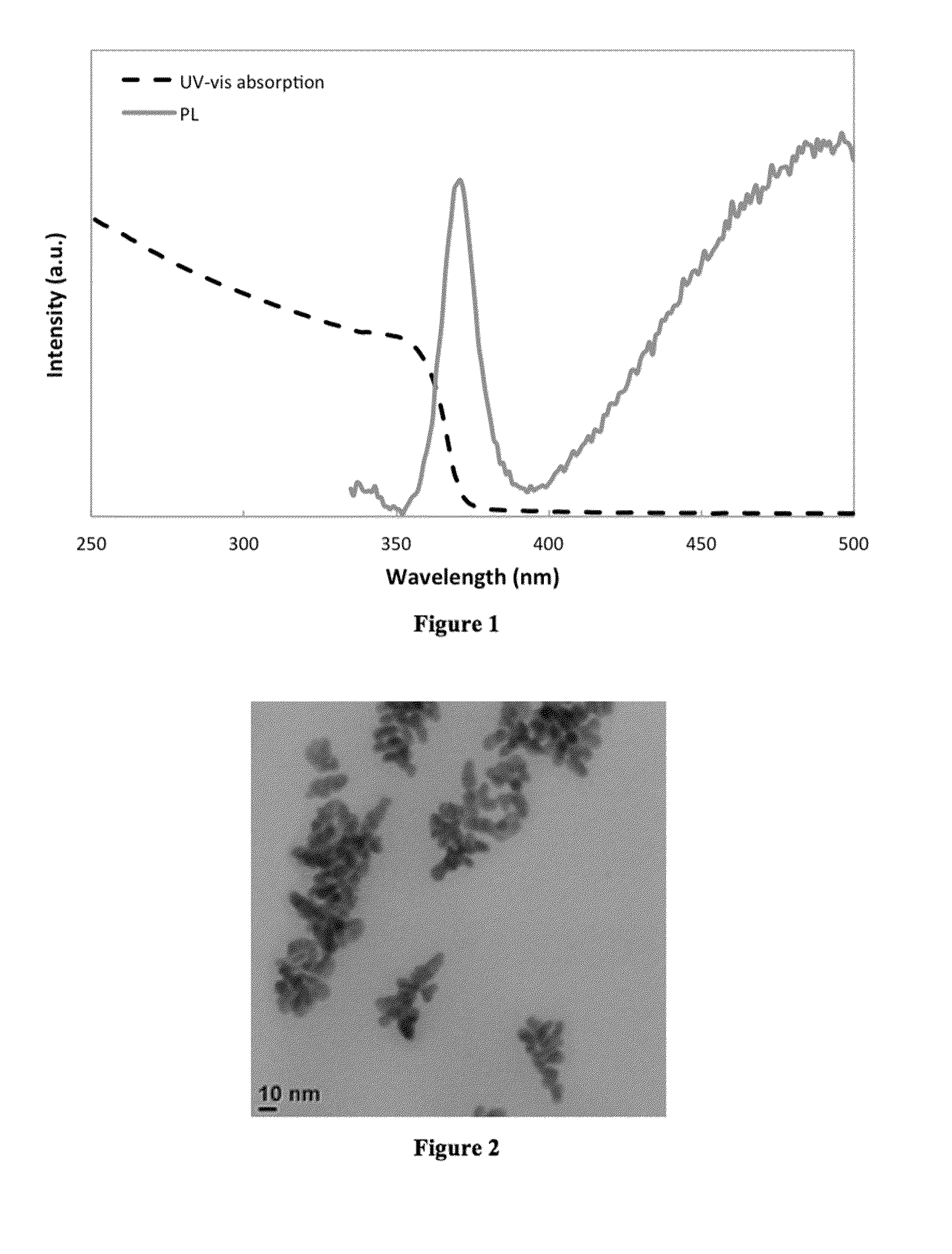Synthesis of Metal Oxide Semiconductor Nanoparticles from a Molecular Cluster Compound
- Summary
- Abstract
- Description
- Claims
- Application Information
AI Technical Summary
Benefits of technology
Problems solved by technology
Method used
Image
Examples
example 1
Synthesis of ZnO Nanoparticles in Hexadecylamine
[0082]HDA (10 g, 41 mmol) was degassed under vacuum at 120° C. Diaquabis[2-(methoxyimino)propanato]zinc(II) cluster (100 mg, 0.30 mmol) was added, dissolving immediately to form a clear solution. The temperature was increased to 150° C. and held for 30 minutes. The temperature was increased to 200° C. and held for 30 minutes, before cooling the solution to room temperature. The product, a white solid, was precipitated with methanol and isolated by centrifugation. UVabs˜355 nm; PLmax=370 nm (FIG. 1). Transmission electron microscopy (TEM, FIG. 2) imaging reveals pseudo-spherical particles with diameters <10 nm, consistent with nanoparticles in the quantum dot regime.
example 2
Synthesis of ZnO Nanoparticles in Hexadecylamine and Trioctylphosphine Oxide, Using Zinc Acetate and Octanol Precursors
[0083]HDA (7 g, 29 mmol) and TOPO (3 g, 7.8 mmol) were degassed under vacuum, at 110° C., for 1 hour. Diaquabis[2-(methoxyimino)propanato]zinc(II) cluster (100 mg, 0.30 mmol) was added and the solution was heated to 200° C. After 35 minutes, the temperature was decreased to 75° C. and the solution was annealed for 2½ hours, before cooling to room temperature overnight. The solution was reheated to 80° C. and zinc(II) acetate (100 mg, 0.55 mmol) was added. The temperature was increased to 180° C. and held for 30 minutes. A solution of 1-octanol in 1-octadecene (3.05 M, 2 mL, 6.1 mmol) was injected in slowly. Once the addition was complete, the temperature was held for 30 minutes, before cooling the solution to room temperature. The product, a white solid, was precipitated with methanol and isolated by centrifugation. UVabs˜335 nm (FIG. 3).
example 3
Concentrated Synthesis of ZnO Nanoparticles in Hexadecylamine and Trioctylphosphine Oxide, Using Zinc Acetate and Octanol Precursors
[0084]HDA (7 g, 29 mmol) and TOPO (3 g, 7.8 mmol) were degassed under vacuum, at 110° C., for 30 minutes. At 70° C., diaquabis[2-(methoxyimino)propanato]zinc(II) cluster (200 mg, 0.60 mmol) and zinc(II) acetate (200 mg, 1.1 mmol) were added and the solution, which was subsequently heated to 200° C. in 20 minutes. 1-Octanol (1.7 mL, 13 mmol) was injected in, dropwise, over 1 minute. Once the addition was complete, the temperature was held for 40 minutes, before cooling the solution to 70° C. The product, a white / yellow solid, was precipitated with methanol and isolated by centrifugation. UVabs˜338 nm (FIG. 4). The X-ray diffraction (XRD) pattern (FIG. 5) is consistent with zincite phase ZnO nanoparticles. N.B. The low angle (2θ<30°) reflections correspond to the capping agent.
PUM
 Login to View More
Login to View More Abstract
Description
Claims
Application Information
 Login to View More
Login to View More - R&D
- Intellectual Property
- Life Sciences
- Materials
- Tech Scout
- Unparalleled Data Quality
- Higher Quality Content
- 60% Fewer Hallucinations
Browse by: Latest US Patents, China's latest patents, Technical Efficacy Thesaurus, Application Domain, Technology Topic, Popular Technical Reports.
© 2025 PatSnap. All rights reserved.Legal|Privacy policy|Modern Slavery Act Transparency Statement|Sitemap|About US| Contact US: help@patsnap.com



